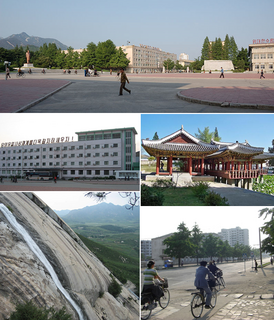
Hwanghae was one of the Eight Provinces of Korea during the Joseon. Hwanghae was located in the northwest of Korea. The provincial capital was Haeju. The regional name for the province was Haeseo.
Namsan is a common name for Korean mountains and hills.

The P'yŏngbu Line is an electrified standard-gauge trunk line of the Korean State Railway running from P'yŏngyang to Kaesŏng in North Korea and further south across the DMZ to Seoul in South Korea; the name comes from the two (theoretical) termini of the line: P'yŏngyang and Pusan.
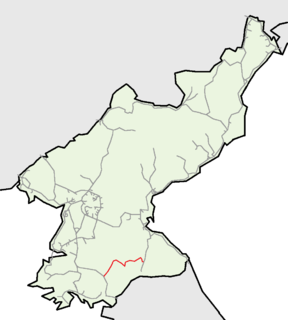
The Ch'ŏngnyŏn Ich'ŏn Line is an electrified standard-gauge secondary mainline of the Korean State Railway running from P'yŏngsan on the P'yŏngbu Line to Sep'o on the Kangwŏn Line. The 141.3 km (87.8 mi) line is the southernmost of the three east-west transversal mainlines in North Korea.
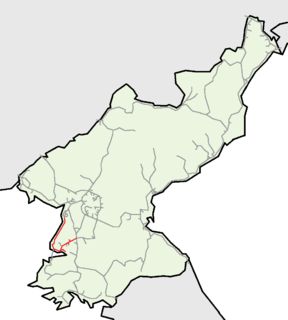
The P'yŏngnam Line is an electrified standard-gauge trunk line of the Korean State Railway in North Korea, linking P'yŏngyang with the port city of Namp'o and the hot springs at P'yŏngnam Onch'ŏn. The length of the line is 89.9 km (55.9 mi).

The Hwanghae Ch'ŏngnyŏn Line is an electrified standard-gauge secondary line of the Korean State Railway in the North and South Hwanghae provinces of North Korea, running from Sariwŏn to Haeju. It connects to the P'yŏngbu Line at Sariwŏn, to the Ŭnnyul Line at Ŭnp'a, to the Paech'ŏn Line at Changbang, and to the Ongjin Line at Haeju. It plays an important role in the transportation of freight and passengers in North and South Hwanghae provinces, serving important mining and industrial areas, as well as one of the DPRK's most important ports for foreign trade.

The Ŭnnyul Line is a non-electrified standard-gauge secondary line of the Korean State Railway in the North and South Hwanghae provinces of North Korea, running from Ŭnp'a to Ch'ŏlgwang. It is an important line in economic terms, connecting the agricultural and ore-producing areas of Kwail and Ŭnnyul counties with the rest of the DPRK.

The Paech'ŏn Line is a partially electrified standard-gauge secondary railway line of the Korean State Railway in South Hwanghae Province, North Korea, running from Changbang on the Hwanghae Ch'ŏngnyŏn Line to Ŭnbit.
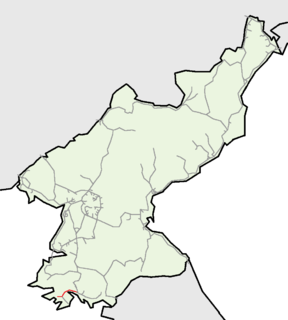
The Ongjin Line is a partially electrified standard-gauge secondary line of the Korean State Railway in South Hwanghae Province, North Korea, running from Haeju on the Hwanghae Ch'ŏngnyŏn Line to Ongjin.
Haeju Ch'ŏngnyŏn Station is the central railway station of Haeju City, South Hwanghae Province, North Korea. Haeju Ch'ŏngnyŏn Station is the terminus of Hwanghae Ch'ŏngnyŏn Line and the origin station of Ongjin Line.

The Chosen Government Railway was a state-owned railway company in Korea under Japanese rule. It was a department of the Railway Bureau of the Government-General of Korea, whose functions were the management and operation of railways in Korea, as well as the supervision of privately owned railway companies.
Namp'o Station is a railway station in Hanggu-guyŏk, Namp'o Special City, North Korea on the P'yŏngnam Line of the Korean State Railway, as well as the starting point of the Tojiri Line. There is an engine house northwest of the station in Munhwa-dong, Hanggu-guyŏk.
The Pongsan Line is an electrified freight-only railway line of the Korean State Railway in Pongsan County, North Hwanghae Province, North Korea, running from Pongsan on the P'yŏngbu Line to West Pongsan,

The Unbong Line is a secondary railway line of the Korean State Railway located entirely within Unbong-rodongjagu, Chasŏng County, Chagang, North Korea, running from Sangp'unggang on the Pukpu Line to Kuunbong.
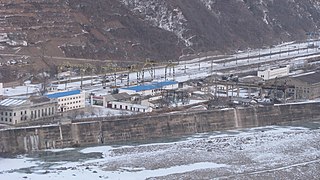
Kuunbong Station is a freight-only railway station in Unbong-rodongjagu, Chasŏng County, Chagang Province, North Korea; adjacent to the Chasŏng Dam on the Yalu River, it is the terminus of the Unbong Line of the Korean State Railway.
Unbong Station is a railway station in Unbong-rodongjagu, Chasŏng County, Chagang Province, North Korea, on the Pukpu Line of the Korean State Railway.
The Chŏngdo Line is an electrified standard-gauge secondary line of the Korean State Railway in South Hwanghae Province, North Korea, running from Wangsin on the Ongjin Line to Chŏngdo.
